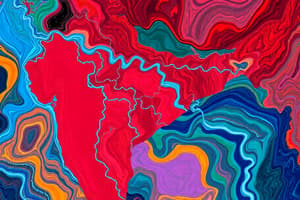Podcast
Questions and Answers
What is the total length of the Kaveri river?
What is the total length of the Kaveri river?
- 1000 km
- 850 km
- 1400 km
- 760 km (correct)
Which of the following is a tributary of the Kaveri?
Which of the following is a tributary of the Kaveri?
- Musi
- Tungabhadra
- Krishna
- Bhavani (correct)
Which of the following states does NOT share the drainage basin of the Krishna river?
Which of the following states does NOT share the drainage basin of the Krishna river?
- Karnataka
- Tamil Nadu (correct)
- Andhra Pradesh
- Maharashtra
What type of lakes are formed by the action of glaciers and ice sheets?
What type of lakes are formed by the action of glaciers and ice sheets?
Which river flows through the deep gorge mentioned in the content?
Which river flows through the deep gorge mentioned in the content?
What is the significance of the Sivasamudram waterfall in India?
What is the significance of the Sivasamudram waterfall in India?
Which lake in Rajasthan is noted for its saltwater characteristics?
Which lake in Rajasthan is noted for its saltwater characteristics?
What is the primary origin of most freshwater lakes in the Himalayan region?
What is the primary origin of most freshwater lakes in the Himalayan region?
What forms the basis for the creation of the Wular Lake in Jammu and Kashmir?
What forms the basis for the creation of the Wular Lake in Jammu and Kashmir?
How much of the total surface water on Earth is freshwater?
How much of the total surface water on Earth is freshwater?
Flashcards are hidden until you start studying
Study Notes
River Overview
- Marble rocks near Jabalpur and Dhuadhar Falls are notable along the Narmada River.
- The Narmada flows through a gorge and is significant for its picturesque landscapes.
- Krishna River spans approximately 1400 km, reaching the Bay of Bengal.
- Tributaries of the Krishna include Tungabhadra, Koyana, Ghatprabha, Musi, and Bhima.
- The Kaveri River originates in the Brahmagri range and flows seaward near Cuddalore, Tamil Nadu.
Kaveri River Basin
- Kaveri River length is about 760 km and it hosts tributaries such as Amravati, Bhavani, Hemavati, and Kabini.
- The Kaveri features India’s second-largest waterfall, Sivasamudram, generating hydroelectric power for Mysore, Bangalore, and Kolar Gold Fields.
Lakes in India
- India hosts various lakes, differing in size, permanence, and formation.
- Permanent lakes exist, while seasonal lakes fill only during rainy seasons, such as those in semi-arid regions.
- Lakes can form through glacial action or human activity; examples include ox-bow lakes and lagoons.
- The Wular Lake in Jammu and Kashmir is the largest freshwater lake, formed through tectonic processes.
- Sambhar Lake in Rajasthan is notable as a saltwater lake.
Importance of Rivers
- Rivers are vital for human settlements and have supported civilizations throughout history.
- Large cities often develop near riverbanks due to the accessibility of water resources.
- The Ganga Action Plan (GAP) Phase-II aims to reduce pollution in major rivers; it covers 152 towns across 16 states.
Economic Role of Rivers
- Rivers provide essential water supply for agriculture, drinking, and hydroelectric power.
- Natural resources from rivers support tourism, recreation, and enhance regional climate.
- Approximately one million litres of sewage treatment is targeted via GAP initiatives.
Quick Facts
- 71% of Earth's surface is water, with 97% being saltwater, leaving only 3% as freshwater.
- Three-quarters of accessible freshwater is frozen in ice.
- Major fresh water lakes in the Himalayas are of glacial origin.
Key Rivers and Lakes
- Notable rivers include Damoder, Brahmani, Baitarni, and Subarnrekha, which flow toward the east.
- Significant lakes include Loktak, Barapani, and various fresh water lakes in the Himalayan region.
River and Lake Conservation Efforts
- Programs like NRCP (National River Conservation Plan) target pollution control and conservation of freshwater resources.
- Successful schemes have been implemented to treat and manage river pollution.
Questions for Review
- Define a water divide and provide an example.
- Identify the largest river basin in India.
- Discuss the origins of the Indus and Ganga rivers.
- Differentiate between natural lakes and those created by human intervention.
Project/Activity
- Engage in map skills by marking and labeling important rivers and lakes across India.
Studying That Suits You
Use AI to generate personalized quizzes and flashcards to suit your learning preferences.




